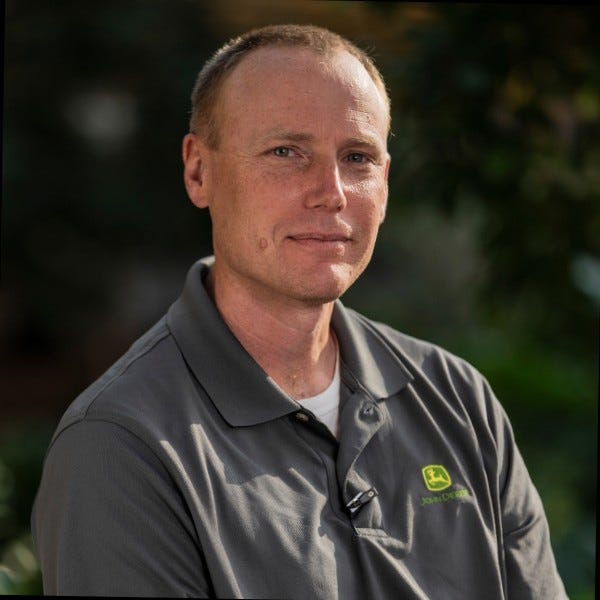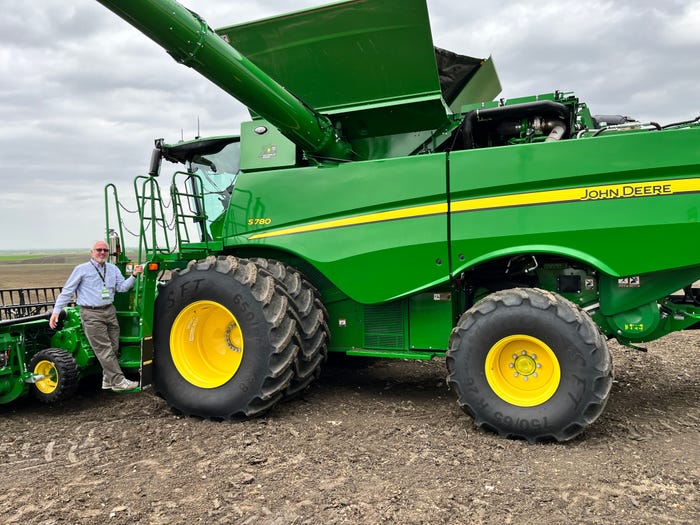John Deere CTO Jahmy Hindman on Tech Transformation on the Farm
‘Farmers view technology as an opportunity to improve the efficiency of their farm’

At the close of the John Deere Tech Summit, a three-day private event for invited media and tech influencers held in Austin, Jahmy Hindman, chief technology officer at John Deere, sat down with Chuck Martin for a discussion on the Deere technology and its current and future role in farming.

Jahmy Hindman, chief technology officer at John Deere
How do you track the volume of technology that's here? How do you deal with all that?
We certainly increased R&D expenditures over the last five to seven years, increasing year over year. We have to pick and choose what part of the waterfront we want to cover and start to understand where some of that technology can be applied in our industries where maybe it's just not mature enough yet or may never be directly applicable in the industry. Part of the way we do that is the startup collaborator environment that we do, both formally and informally.
There is significant effort around maintaining contacts and familiarity with what's going on in the startup community. We formalize that in the startup collaborator every year where we bring in six to 12 different companies and partner with them to figure out if what they're working on is somewhat applicable to our space and to the problems of our customers.
We typically work with them first before making an acquisition or we need to buy or build, there's probably not a one size fits all. Sometimes the folks in the startup collaborator result in a partnership or an acquisition.
In some cases, it's a business relationship and commercial relationship, a partnership and in some cases it just doesn't work. And we're not willing to let go that maybe we need to put more time and effort into it. So let's continue to work on the problem together. And in some cases, it doesn't work, so we go our separate ways, and may go focus on a different problem to solve.
So what's your big problem?
Transformation. What you saw today in terms of autonomy in agriculture was a down payment on where we're headed. It was a one-machine farm, a tractor and one application with a tractor. If you think about all the jobs that happen in agriculture, being able to execute autonomy across all of them is much more complicated than where we started. It's a different machine form.
If you think of the sprayer that you saw today, a-120 foot boom. The perception system that we have to adopt on a machine like that is different than what we put on the tractor. It's 120 feet wide. It takes significantly more sensing elements to sense in that environment than it does on the tractor. If you think of a combine, it’s the actual harvest where you're in the crop.
When that combine is going through crops, being able to perceive what's in the crop, a standing crop is different than when the field doesn't have any crop in it. One of the major challenges ahead of us is this idea of sensor modality. In addition to stereo vision, which is the stereo cameras we used on the tractor today, what else do we need to use from a sensor modality perspective? And does it always have to be on the vehicle or not? Could you, for example, fly over a field with a drone and an infrared element sensing element to understand if there's something in the field that shouldn't be there, and then monitor the field boundary while the machine is operating within the field?
That's the challenge. It's in front of us in the autonomy space, working through all the different use cases: dust, standing crop, no standing crop, light, daylight hours, dark hours, all of those things trying to solve for that problem.
Would you look at moving to a SaaS (software as a service) model for anything?
Yeah, absolutely. Much of what you saw today both See and Spray and the autonomous application will be partially deployed with what we'll call a renewable license model where it may be a pay-per-use type of business model. We're still working on what that model needs to look like as customers. Maybe we only charge per acre that you use the technology. And in the case of the autonomy, maybe we only charge you per hour that you're using the tractor with the autonomy solution turned off, charge by plan. So that's sort of a brave new world unto itself.

Author Chuck Martin next to one of John Deere's machines
We haven't quite figured out what the right way is to commercialize it and for customers to digest the use of it. We also are cognizant of the reality that so much of that value is created via software and we have the ability to improve the software over time. For example, See and Spray works in corn, soybeans and cotton. But if a farmer grows wheat or if they grow rice or if they grow some other variety of crop, we want to be able to offer that solution to that as well. Maybe that's new software we can deploy to that machine to make it more capable moving forward and of higher value to the grower. But it's software and all we have to do is put another machine learning model on the existing hardware.
New software is simply incremental but it's going to invent something totally new. It’s both like the autonomy thing is completely new and we will add incremental capability to that core foundation of the core autonomy stack over time. So I think I think it's both.
Do you ever get rid of the cab?
That's a fantastic question. I get asked that frequently. I've figured much of an answer. I think the answer is, I won't rule it out in the future. But that future’s a long way away for a couple of reasons.
The first one is we still require the farmer to drive the tractor to the field. There's still an on-highway element that we don't operate on autonomously and frankly, we're not very interested in solving that problem. It's a very small portion of value creation to a grower. As long as you still have to drive the tractor, from the farmyard to the field on the highway, you need an operator station to do that. The tractor in particular is somewhat unique in this regard. It's used for lots of things on a farm. It's used for tillage applications. It’s used for planting applications. It's used for pulling that green cart that you saw operated today. It's even used for moving snow in northern climates.
There are many of those jobs that are not fully autonomous today. Some of them may never be fully autonomous, like moving snow on the farm. They need to be able to operate a machine manually or have a human in the loop if you will. It’s going to be around for quite a while.
Would you use swarm technology?
Obviously, some future where you look at some swarm approach. We have smaller technology but a lot of it I won't rule it out. One of the biggest challenges in agriculture with that is the logistics side of things. It's the tendering operation. If you think of tendering today – by tendering, I mean providing seeds and fertilizer to a planter or providing the chemicals to a sprayer when you have multiple machines in a field all operating in a coordinated fashion – tendering those machines becomes very difficult. Because they don't all run out of product at the same time. They don't all show up and be tendered at the same time.
The answer to the question, in my mind, is there's a future out there where swarms may work, but you have to solve the logistics problem in order to make that interesting to a farmer because a significant part of their inefficiency today is the technical operation, logistics of the farm.
How do you integrate with the rest of Deere in terms of technology and everything else that it does?
It's a good question. We centrally organized the technology development part of Deere, with the idea that we can leverage that technology across multiple use cases. The same stereo cameras on both See and Spray and the autonomous tractors are being deployed in construction applications and road-building applications.
The guidance that you saw working on all the agricultural equipment today can be deployed on construction equipment and road building equipment as well. We try to centralize some of the technology development with the idea being that we cannot recreate the wheel everywhere and redeploy that technology across as many use cases as we can.
Are you involved in internal technology as well or just customer facing?
Mostly customer facing. There's some internal technology that we deal with relative to cloud infrastructure, those sorts of things that we use for engineering and product development purposes.
When someone comes to you and says, can we use GPT, is there another group that handles that kind of thing?
There are a couple of different entities within the company that will wrestle with that. There’s a legal entity and it's going to have an opinion, obviously. There's an IT group, our own internal information technology group is going to weigh in with a viewpoint on whether or not that's helpful and useful or not. And there's sort of the end users like folks in my organization that are interested in using it to try to improve software development, efficiency and those sorts of things.
So the answer is no, we're never going to say we're never going to use it. It's interesting. It's compelling in many cases, but it comes with a significant number of risks. We're in the middle of trying to understand can we mitigate some of those risks? Is there a way through this and when would it be, when is the right time for us to start to utilize it in a productive way.
But your group doesn't have to mess with that?
That's right. We certainly get to provide an opinion into that, but it's one of several opinions.
So what does the farmer of the future look like?
That's a fantastic question. I think they're data driven like the farm. The farmer of the future doesn't farm without using a tool like the John Deere operation center to help manage their farm. It is a job that is made easier to optimize when you have access to useful information.
The farm of the future is extremely data driven. It's much more precise. We talked about plant-by-plant management. Farmers of the future will think about that as opposed to thinking about how productive is this field. They're going to be thinking about how productive is this section of the field and eventually, how productive are my individual plants. They're also increasingly technologically savvy, and they have to be. The farm is a business that is extremely technology driven. And it's that way for a good reason. Farmers view technology as an opportunity to improve the efficiency, the economic sustainability and the environmental sustainability of their farm.
It also seems relatively easy to grasp, at least based on what I've experienced here.
It's easy to understand, once you're in the farm and operating environment, how the farm operates. It's much more difficult to make decisions with incomplete information with the business side of things, understanding what future prices are, what your input prices are doing, and what the weather forecast looks like and what your labor pool is, where you happen to be farming, what your crop rotations need to be given changes that are happening and varieties and genetic modifications of plants and changing weather patterns and the changing conditions on your farm. All of those things. They are consequential elements in the business and it’s highly nonlinear.
A year from now we're sitting here having this conversation. What would we be talking about?
That's a fantastic question, too. One of the things I'm the most excited about because it's very near term, but it's difficult to overestimate the importance of it, the ability to connect every farm. Maybe I'll rephrase that intentionally. The ability to connect every acre of every farm is becoming increasingly more important.
We're going to be talking about our opportunity from a connectivity perspective, ubiquitously having connectivity everywhere. And what opportunity that opens up for us like we didn't talk about. One of the interesting things about that is if you can guarantee one of the things that pushes us to do so much compute on the edge on the vehicle, is because we can't guarantee connectivity. If you don't have the connection, I can't necessarily do the compute and I need to.
If I have guaranteed connectivity, I start thinking about how compute takes place differently. Do I have to have the GPU sitting on the machine? Or can I push information off the machine with guaranteed connectivity to do the smart stuff off board and just do machine controls on board? That's the sort of thing that'll be really interesting to see if we can crack that nut over the next 12 to 16 months.
What did I not ask you that I should have?
There's certainly a question around what powers the agricultural equipment of the future. You still have to put power into the equipment. Where does that come from? We showed a fully battery electric backhoe today. That landscape of where the energy comes from in agriculture is going to change in the next five to 10 years. And it's a much more complicated future than what we have today, largely dominated by two fuels, gasoline and diesel fuel.
The infrastructure to support them is mature. It's how the world operates and it's remarkably consistent globally. That changes with time. The way that machines are powered in the future is going to be different based on the duty cycle. In some cases, full battery electric might make sense. In some cases, hybrid electric might make sense.
In the top end, we talked a little bit about it yesterday with biofuels. Where does the feedstock come from? In this country, it predominantly would come from corn and soybeans. That's what we grow. In Brazil, it comes from sugar cane. And it's an ethanol form and it's increasing. It's incredibly successful in Brazil actually, the majority of their on-highway fuel comes from sugar and or corn ethanol. And that's going to look different in different areas of the world. We have to be able to accommodate a more complex environment of energy, storage and energy use moving forward than we do today.
This is the fifth in a series on how John Deere is taking high-tech farming to the next level.
Read more about:
Smart FarmingAbout the Author
You May Also Like








